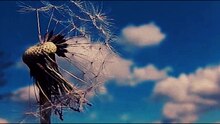
My friend Bob waxed eloquent when he typed wisdom on his computer keyboard and posted it on Facebook:
"Right now the yard of our 'little house where the sidewalk ends' is filled with dandelions, perhaps to the befuddlement or bewilderment of our good neighbors with their beautiful manicured lawns. However, they are kind people and there appears to be no bitterness in their hearts over our abundance of yellow treasures. We love our dandelions! For us they are not weeds but food for man and beast, bright, spring wild flowers to cheer the soul. To us dandelions mean HOPE."
What is this mysterious wild flower that can clone itself multiple times without any effort?
The name comes from the French dent de lion meaning "lion's tooth."
 Like other members of the Asteraceae family, the flower head is not simply one blossom, but is actually composed of dozens of tiny individual flowers collected together into one composite floret which can reproduce without pollination.
Like other members of the Asteraceae family, the flower head is not simply one blossom, but is actually composed of dozens of tiny individual flowers collected together into one composite floret which can reproduce without pollination.
After flowering is finished, the dandelion flower head dries out for a day or two, goes to seed, and the white-headed floret is now a mega-bunch of seeds. The whispy blowball of little parachutes opens into a full sphere. Each little parachute is a seed capable of becoming another offspring genetically identical to the parent plant.
 The seeds are wind-bourne or "kid-bourne" as children have fun blowing the floret to the wind. (I loved doing that as a child!) That's why dandelions disperse and multiply so fast!
The seeds are wind-bourne or "kid-bourne" as children have fun blowing the floret to the wind. (I loved doing that as a child!) That's why dandelions disperse and multiply so fast!Did you know the little dandelion heads get tired and close up to sleep under the stars at night and open again at dawn to reflect the morning sun? As a child, have you ever put the flower under someone's chin to see if their chin turned yellow? If it did, they were supposed to love butter! (I did that as a child!)
It is considered a noxious weed and nuisance in residential and recreational lawns and golf courses because they have long tap roots and so are difficult to get rid of. On the other hand, they have been used by animals and humans for food and for herbs since pre-history.
Either raw in salads or boiled to reduce the bitterness and seasoned, the leaves are not only delicious but contain abundant vitamins and minerals, especially vitamins A, C and K, and are good sources of calcium, potassium, iron, and manganese. The flower petals, along with other ingredients, usually including citrus, are used to make dandelion wine. (I know--my grandfather used to make it.) The ground, roasted roots can be used as a caffeine-free dandelion coffee. Dandelion is one of the ingredients of root beer. The leaves were once delicacies eaten by the Victorian gentry, mostly in salads and sandwiches.
Historically, dandelion was prized for a variety of medicinal properties, and it contains a wide number of pharmacologically active compounds. It has been used in herbal medicine to treat infections, and bile and liver problems.
The dandelion plant is a beneficial weed even as a good companion plant for gardening. Its deep, long and strong taproot (I know how long and strong...I had to dig up dandelions on our lawn every year!) brings up nutrients for shallower-rooting plants, and adds minerals and nitrogen to soil. It is also known to attract pollinating insects and release ethylene gas which helps fruit to ripen. How marvelously God planned for the network of interdependence of His creation!
From Genesis to Revelation the Bible speaks of God's provision of creating plants for eating and for medicine. And He sprinkled plants throughout the earth in multiplied varieties and colors simply for beauty, for the enjoyment of the people whom He created. Even those flowers which you can't eat and from which you can only derive visual pleasure and fragrance. Jesus spoke of the flowers of the field, the striking beauty in which God clothed them, and their exemplary attributes for us.
Just because dandelions are so common and ordinary let's not discount God's creative hand in blessing us with so many of them. Let's recognize their beauty and their usefulness. Likewise, there are no common and ordinary people--all are unique and precious in His sight and Jesus gave His life for each of us.
Yes, Bob, the dandelion is a "HOPE" flower, not a noxious weed. So enjoy! Of course your neighbors might not be as happy when thousands of little "parachutes" come sailing on the wind in the direction of their lawns!
No comments:
Post a Comment